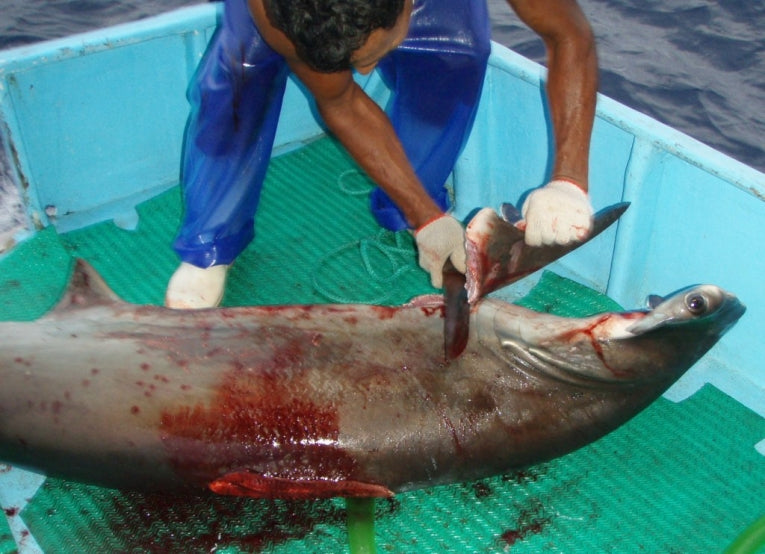The shark is a beautiful creature to those who know it. Its physiology is unique, its streamlining is remarkable and the species (480 detailed here) have colonised every niche imaginable, from the deep sea trenches to those pelagic species (like the silky below) that patrol the oceans.
The PEW Charitable Trusts have championed the shark and shark conservation for many years and have just come out with a new set of strategies. They highlight slow growth, few offspring and late maturation as one set of disabilities in the current situation.
We also know precious little about how many sharks are caught as they are not classed as other fish are within fishing industry figures. The shark however is suffering from simple human greed.

Credit: © Pew Environment Group
Above: Shark fishing globally is driven largely by the demand for fins for soup. According to data from Hong Kong's Census and Statistics Department, 83 countries or territories supplied more than 10.3 million kilograms (22.7 million pounds) of shark fin products to Hong Kong in 2011.Hong Kong possesses 50% of the shark-fin market.
While some (thresher sharks, oceanic white-tip sharks,hammerhead sharks, silky sharks, spiny dogfish, porbeagle sharks, basking sharks, and 17 species of deep-sea sharks) are protected to a limited extent, all shark species are subjected to the ancient but increasing habits of certain Chinese restaurateurs.
Of the migratory sharks, 82% are threatened or near-threatened with extinction. These species travel far and wide, enabling catches by the organised fisheries where countries have fewer regulations! Their fate seems obvious. Despite the odds, they have to be saved from extinction.
Precious in their ecosystems, the loss of these species will cause collapse in commercial fisheries as well as in populations of other important animals (and plants). Of this highly migratory group, only the basking, great white and whale shark have global management procedures in place to protect them.

Photographed off Cuba, the Silky shark (Carcharhinus falciformis) is a highly mobile ocean-goer, involved heavily (i.e. over-fished in all probability) in shark fisheries, but itself fishing for tuna and mackerel. It contrast with its bulkier cousin-the bull shark - Silky shark; Credit: © Shutterstock
So this global compendium, Navigating Global Shark Conservation: Current Measures and Gaps, is in fact analysing the paucity of data (of only 150 species) available to the FAO at their Rome meeting from July 9th to the 13th.
Shark fin soup is a Chinese delicacy. Any shark fin will do, as the soup is clear and tastes of very little. Of the 190 countries in the FAO, 83 supply Hong Kong alone with fins. Only 33% ban finning, even for endangered species.
Finning leaves the live 'finless' fish in the water and simply takes the fin back to make soup. The inadequacy of the protections match the futility of approaching lobbied politicians who can't, won't, or 'shouldn't' act.

Killed for shark fin soup; Credit: © Earth Times
The old dilemma strikes again with how to globally act? We need to prevent many sharks from finning as well as from fishing gear and general fishing bycatch. The answer PEW recommends with its great experience on so many marine matters, is:
Endangered shark species' fins have to be prohibited at market as well as being kept on their "owners" at sea. Specialist checking will prevent the loss of many of these species, although the cost of implementation seems high. Other species are badly affected as sharks disappear. PEW advocate these spp. must be protected too, with the following actions:-

The bull shark, Carcharhinus leucas, frequents shallow seas and estuaries worldwide and, because of this, is familiar to many people. It fits into its ancient reef ecosystem as a true top predator, while many sharks function as prey organisms and scavengers in every ocean system - Bull shark image; Credit: © Shutterstock
The future is ours, but it must belong also to the shark, the panda and the frog.
We really can't afford to lose our allies in the ecosystem as the human population approaches crisis after crisis.










